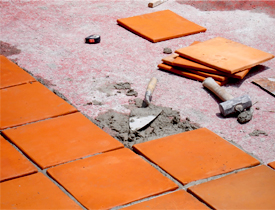Unglazed Quarry Tile
 Unglazed quarry tile is kiln-fired ceramic tile without a glaze added for color or a glossy finish. If you wonder what it looks like, visit your nearest fast-food restaurant and peer beyond the counter into the kitchen: that reddish square or rectangular tile floor is almost sure to be quarry tile. But don’t let the image of a greasy kitchen stain your perception of unglazed quarry tile. It’s a durable and attractive material that makes excellent flooring throughout the house—and outdoors.
Unglazed quarry tile is kiln-fired ceramic tile without a glaze added for color or a glossy finish. If you wonder what it looks like, visit your nearest fast-food restaurant and peer beyond the counter into the kitchen: that reddish square or rectangular tile floor is almost sure to be quarry tile. But don’t let the image of a greasy kitchen stain your perception of unglazed quarry tile. It’s a durable and attractive material that makes excellent flooring throughout the house—and outdoors.
What is unglazed quarry tile?
Despite what its name might suggest, quarry tile is not stone—not anymore, at least. Its name comes from its resemblance to natural cut stone tile of the past. Today, quarry tile is made with clay and is fired at high temperatures to create a very dense tile with high compressive strength (which means it won’t crack under heavy loads or foot traffic). Like porcelain tile, unglazed quarry tile is color-through, so if it does happen to crack or chip, you won’t see layers of color variation like you would with glazed ceramic tile.
Benefits of Quarry Tile
The main benefits of unglazed quarry tile are its strength, slip-resistance and natural coloring, as well as its suitability for outdoor use (see note below). All of these characteristics make it an ideal tile choice for patios, walkways, front stoops and pool surrounds. Indoors, quarry tile is a good option for foyers and other high-traffic areas and for bathrooms. It’s not commonly used for walls, but it certainly can be. Note: If you plan to use quarry tile outdoors, make sure it is “vitreous” and is rated for freezing temperatures.
Sizing and Cost
Unglazed quarry tile comes in a limited range of standard sizes. Colors are primarily earth tones ranging from reds to soft grays and browns. The most common sizes, in inches, are 3 x 6, 6 x 6, 4 x 8 and 8 x 8. You can also find it in larger squares or in hexagons and other shapes. Tiles in standard sizes and finishes are at the low end of the cost spectrum of residential tile options. Quarry tile is also available with special textures and slip-resistant surfaces, eased or “tumbled” edges and even a wire-cut finish (commonly found on clay brick), any of which can add to the cost and might require special ordering.
Installation
The basic installation process for unglazed quarry tile is the same as for standard ceramic tile. For wet areas indoors, be sure to use cementboard installed over a suitable subflooring or wall framing, as applicable. Set the tiles with thinset (mortar-based) adhesive, unless directed otherwise by the manufacturer.
Outdoors, tiles should be laid over a stable, flat concrete surface, using a thinset adhesive rated for freezing temperatures. Due to the lack of glazing, special care must be taken when grouting with dark-colored grouts, which can leave traces of color in the tile. In such cases, you can apply a special release agent (not a permanent tile sealer) to the tiles before grouting; ask your tile dealer for recommendations. Unglazed quarry tile can be sealed or left unsealed.
In a nutshell, if you need a hard-wearing tile and like the natural clay coloring of brick or Saltillo tile, quarry tile is a great option, for indoors or out.
Find a reliable contractor to install your unglazed quarry tile.
Updated June 21, 2018.
Looking for a Pro? Call us (866) 441-6648

Tile Contractors Experiences

Floor Tile Replacement In Every Inch Of The House

Why I Chose Tile Floors After A Horrible Water Damage Experience



